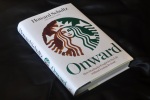I just finished the book Onward by Starbucks CEO and President Howard Schultz co-authored by Joanne Gordon detailing Starbucks’s remarkable turnaround from several years of failed rapid growth preceding the recession that resulted in about 600 stores closing amidst the recession, and most of them were opened only 18 months prior! Starbucks Corporation has over 14,000 stores worldwide. It raked in $11.7 billion in revenues and $2.4 billion in earnings. Its increasing global presence is leading the company toward a newly reinvigorated growth model. But Starbucks was in trouble in 2007. It was growing too fast. It wasn’t meeting its financial metrics; same store sales were on a sustained decline. Massive promotional and pricing campaigns from competitors such as McDonald and Dunkin’ Donuts threatened Starbucks’s customer base. Columnists as-a-matter-of-fact-ly voiced against the indulgence of “$4 latte” in bad economic times. Against great odds to regain organizational and market confidence, Howard Schultz returned to Starbucks in 2008 knowing that he 1) could not simply dwell on the past; innovation is a must; and 2) there is no time for throwing blames; instilling confidence will be his #1 priority. With this mindset, Schultz rolled up his sleeves and went to work, on something that is only second to his family in terms of importance and love.
What I came away from the reading is an inescapable appreciation for this man’s love and passion for his job, and the company he has built 40 years ago. Starbucks means the world to him. There is a soulful connection he has made with the readers acting almost as an excited kid showing off a magic trick he has pulled off in the last two years. “Magic” was cited by Schultz as the impetus that drove his entrepreneurial spirit, for “as a boy at the Horn & Hardart Automats in New York City, where I [Schultz] was amazed by the ‘magically’ reappearing food. Even at a young age, I began to realize what it means to be a merchant.’” Some of Schultz’s qualities strike me as notable mini-lessons on leadership:
- His attention to details (Founder’s Conviction): reteach all Starbucks baristas on how to steam a perfect cup of espresso through a nationwide training video, commitment to get rid of the foul smell of burnt cheese in the oven from overtaking the natural coffee aroma in the stores, baristas’ ability to make eye contact with customers over the brewing machine, etc.
- His every effort to connect with customers and to bring coffee to life (Relevance): implementing Starbucks Rewards program, asking leadership to redesign Starbucks stores, using social media, commit Starbucks to community service, utilizing crowdsourcing through MyStarbucksIdea.com, and constantly innovating – rolling out Pike Place Roast and VIA to revitalize Starbucks’s core competency.
- His repetitive emphasis for Starbucks to be about people (Soul): ethically sourcing coffee throughout the Starbucks supply chain – leading the industry as the number one buyer of Fairtrade-certified coffee, never let go the “sacred cow” that is the comprehensive health care package that all Starbucks partners and baristas enjoy, his conviction to improve the company morale and culture through a large scale leadership conference for 10,000 Starbucks partners and managers in New Orleans, his leading effort to build more farmer support centers in East Africa to allow coffee growers to increase their productivity yield, thus more money in their pockets, etc.
Howard Schultz wrote this book with much humility and humanity with little corporate pretense. From time to time, you can pick up on his disdain toward the financial guys, the Wall Street people, who do not understand what Starbucks is all about. As part of the Transformation Agenda he and his team drafted to turnaround Starbucks, the new bold mission for the company reads: “To inspire and nurture the human spirit one person, one cup, and one neighborhood at a time” The number 40,000 – the desired number of stores Starbucks would have liked worldwide – used to intrigue Schultz, but then he realized that number would not mean anything without the focus of one. Going back to an earlier post I wrote, Starbucks epitomizes the kind of 21st century corporate responsibility model that multinational firms need to adopt, in which the leadership puts a human dimension on corporate success, where profits come with social responsibility for the very people and communities affected by the business.
Schultz’s renewed emphasis on customer service, on human connection, on constantly refining and improving Starbucks’s value proposition made him an admirable 2nd timer CEO who righted his ship of enterprise and steered it toward financial stability and regained the trust of its own people and consumers at large. An amazing documentary narrative and memoir worth reading. I would recommend Onward to anyone who looks to be inspired by organizational leadership, love, passion, conviction, decision making, and effective communication in uncertain times. This book serves as a valuable, personal inspirational piece examining these topics through the eyes of a CEO who is leading one of the most resilient and innovative beverage corporations in the world.




